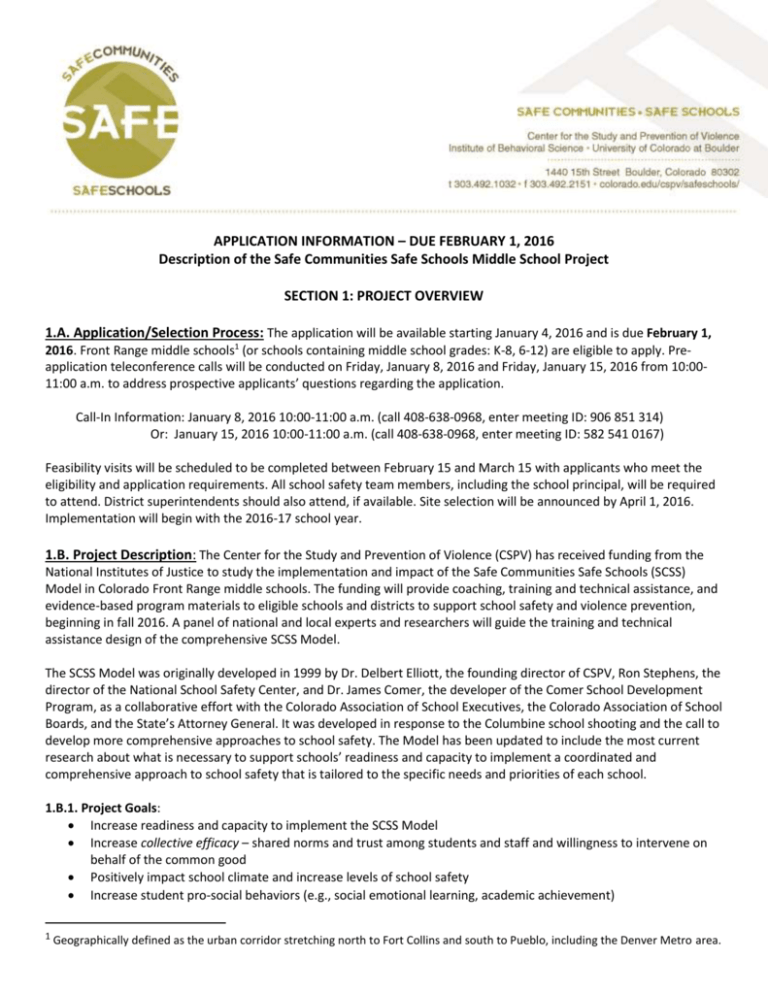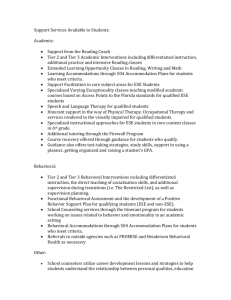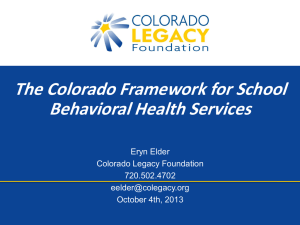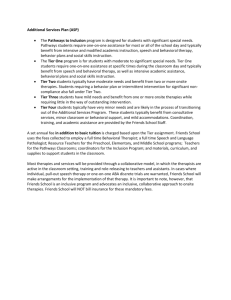Safe Communtities Safe Schools Grant Application
advertisement

APPLICATION INFORMATION – DUE FEBRUARY 1, 2016 Description of the Safe Communities Safe Schools Middle School Project SECTION 1: PROJECT OVERVIEW 1.A. Application/Selection Process: The application will be available starting January 4, 2016 and is due February 1, 2016. Front Range middle schools1 (or schools containing middle school grades: K-8, 6-12) are eligible to apply. Preapplication teleconference calls will be conducted on Friday, January 8, 2016 and Friday, January 15, 2016 from 10:0011:00 a.m. to address prospective applicants’ questions regarding the application. Call-In Information: January 8, 2016 10:00-11:00 a.m. (call 408-638-0968, enter meeting ID: 906 851 314) Or: January 15, 2016 10:00-11:00 a.m. (call 408-638-0968, enter meeting ID: 582 541 0167) Feasibility visits will be scheduled to be completed between February 15 and March 15 with applicants who meet the eligibility and application requirements. All school safety team members, including the school principal, will be required to attend. District superintendents should also attend, if available. Site selection will be announced by April 1, 2016. Implementation will begin with the 2016-17 school year. 1.B. Project Description: The Center for the Study and Prevention of Violence (CSPV) has received funding from the National Institutes of Justice to study the implementation and impact of the Safe Communities Safe Schools (SCSS) Model in Colorado Front Range middle schools. The funding will provide coaching, training and technical assistance, and evidence-based program materials to eligible schools and districts to support school safety and violence prevention, beginning in fall 2016. A panel of national and local experts and researchers will guide the training and technical assistance design of the comprehensive SCSS Model. The SCSS Model was originally developed in 1999 by Dr. Delbert Elliott, the founding director of CSPV, Ron Stephens, the director of the National School Safety Center, and Dr. James Comer, the developer of the Comer School Development Program, as a collaborative effort with the Colorado Association of School Executives, the Colorado Association of School Boards, and the State’s Attorney General. It was developed in response to the Columbine school shooting and the call to develop more comprehensive approaches to school safety. The Model has been updated to include the most current research about what is necessary to support schools’ readiness and capacity to implement a coordinated and comprehensive approach to school safety that is tailored to the specific needs and priorities of each school. 1.B.1. Project Goals: Increase readiness and capacity to implement the SCSS Model Increase collective efficacy – shared norms and trust among students and staff and willingness to intervene on behalf of the common good Positively impact school climate and increase levels of school safety Increase student pro-social behaviors (e.g., social emotional learning, academic achievement) 1 Geographically defined as the urban corridor stretching north to Fort Collins and south to Pueblo, including the Denver Metro area. Address mental health needs and reduce student problem behaviors (e.g., delinquency, bullying, violence) 1.B.2. Addressing Senate Bill 213: Recent state legislation (SB 15-213) has increased the burden on schools to “exercise reasonable care to protect students, faculty, staff, and others from harm that is reasonably foreseeable while such students, faculty, staff, and others are within the school facilities or are participating in school-sponsored activities.” Schools now face financial liability for injuries sustained by violent acts that could have been prevented. The SCSS Model is designed to help support schools in meeting that standard of care. 1.C. Overview of the SCSS Model: The SCSS Model works in close partnership with schools and communities to deliver the most effective programs and strategies known to impact school safety and prevent violence in ways that are tailored to their unique needs. The Model consists of 3 Core Components (pictured below) and an implementation framework called the SCSS Implementation Road Map that strengthens, integrates, and aligns existing efforts (e.g., Positive Behavioral Intervention and Supports (PBIS) into a coordinated, strategic approach that addresses gaps related to school safety and violence prevention efforts and promotes student wellbeing. The SCSS Implementation Roadmap outlines a five-phase process for delivering evidence-based programs and strategies to meet each school’s unique dataidentified needs while maintaining fidelity to the SCSS Model. 1.C.1. The SCSS Model 3 Core Components include: (1) engagement of a multidisciplinary school design team (MSDT)2 and the development of key community partnerships committed to data-based decision making, cultural responsiveness, fair and consistent disciplinary practices, and school-wide change, (2) implementation of an effective intelligence gathering system to collect and interpret data at the school (e.g., climate, attendance, discipline, rates of bullying, violence, victimization, and mental health) and student levels (e.g., screening and assessment to identify early indicators related to individual students’ behavioral and mental health needs), and (3) development of an evidence-based multi-tiered system of supports (MTSS) that includes a schoolwide approach to social and emotional learning (SEL) and builds staff capacity to identify and address student needs at the universal (i.e., all students), targeted (i.e., some students), and intensive levels (i.e., a few students). 1.D. Funding and Partnerships: Funding for this project is provided to the University of Colorado Boulder by the National Institute of Justice, Office of Justice Programs, U.S. Department of Justice, as part of their Comprehensive School Safety Initiative [Award No 2015-CK-BX-K002 - 2015-91653-CO-IJ]. CSPV has partnered with multiple statewide agencies to help support this effort, including the Colorado School Safety Resource Center, Colorado Department of Education, Colorado Division of Criminal Justice, Colorado Department of Human Services, Colorado Department of Public Health and Environment, Colorado Division of Behavioral Health, Colorado Attorney General’s Office (including Safe2Tell), Colorado Association of School Executives, Colorado Association of School Boards, Colorado Education Initiative, and Colorado Association of School Resource Officers. SECTION 2: PROJECT IMPLEMENTATION PLAN (REQUIREMENTS, BENEFITS, AND TIMELINE) 2.A. Staggered Implementation Plan: Implementation of the project model will be staggered with 9 schools starting each year of the project, so that all 36 schools will receive the intervention by Year 4. Schools that are selected to participate will be required to sign an agreement that details the roles and responsibility of each party and procedures to ensure the independence and objectivity of the research. Schools in the control group will receive a $1,000 stipend for the years they are in the control group. Year 1 intervention schools will participate in research activities and receive 2 Multidisciplinary school design teams (MSDT) will include school administrators, counselors, lead teachers, student representatives, and community partners (i.e., law enforcement, juvenile justice, social services, mental health agencies, parents). The MSDT will oversee the development and implementation of the school’s action plan and oversee the integration of the SCSS Core Components in the school’s daily practices. the program model all four years. Year 2 intervention schools will participate in research activities all four years and receive the program model in years 2-4. Year 3 intervention schools will participate in research activities all four years and receive the program model years 3-4. Year 4 intervention schools will participate in research activities all four years and receive the program model in year 4. 2.B. School/District Eligibility Requirements and Benefits: Table 1: Eligibility Requirements and Benefits Overall Eligibility Requirements: 1. Front Range middle schools (or schools containing middle school grades: K-8, 6-12) 2. Support and commitment of school leadership and school safety team members (school and district levels) 3. Willingness to participate as an intervention or control site 4. Administration of annual SCSS school climate surveys for students and staff (beginning fall 2016) 5. Willingness to share school-level data (attendance, behavior, academic outcomes) 6. Participation in two 1.5-day trainings per year and ongoing technical assistance for school teams; additional training and technical assistance for evidence-based programs, strategies and policies will be based on individualized school action plans 7. Collection of data about program implementation, including interviews and annual feedback surveys and possibly classroom observations 8. Staff Interviews and feedback opportunities for continuous feedback to ensure evidence-based strategies and programs are feasible and helpful Schools Will Receive: 1. Intensive training, coaching and technical assistance around the SCSS Model Core Components 2. Comprehensive school climate data and student-level screening and assessment tools 3. Tools and resources to support monitoring school climate and safety 4. Social emotional learning strategies for staff and students 5. Training and materials for one Blueprints for Healthy Youth Development program 6. Training and technical assistance in developing a tiered system of evidence-based prevention and intervention programs, practices and policies matched to student and school need 7. The opportunity to participate in a Community of Practice with other schools and districts 8. $1,000 stipend for years in the control group 2.C. Training, Technical Assistance, Coaching for Multidisciplinary School Design Team (MSDT): 1. Two 1.5 day trainings per year beginning in Year 1 (for intervention schools) and meet on a monthly basis (full team) and bi-weekly (sub-team) to guide implementation. 2. The SCSS Project Team will provide bi-monthly proactive consultation and coaching to each school’s MSDT to facilitate data-based decision making, schoolwide engagement in the project, and effective implementation of selected evidence-based programs and strategies. A skilled facilitator will attend the monthly MSDT meetings as needed during the Year 1 planning period. 3. The SCSS Project Team will work with the intervention schools to determine how to integrate the training, consultation and coaching into their existing meeting and professional development structures. 4. MSDTs will oversee the development and implementation of their individualized School Action Plans. These plans will be aligned to the SCSS Core Components and tailored to each school’s specific needs and capacity. Training and technical assistance/coaching resources will be provided to support the school’s individualized action plan during the implementation phases. 2.D. Evidence-Based Program Implementation: Schools will select and receive funding to implement one program from the following list of Blueprints for Healthy Youth Development Programs. Full descriptions of each program are available on the Blueprints for Healthy Youth Development website: http://www.blueprintsprograms.com. Table 2: Blueprints for Healthy Youth Development Program Menu Blueprint Program Program Type Achievement Mentoring (formerly Behavioral Monitoring and Reinforcement Program) Cognitive Behavioral Intervention for Trauma in Schools (CBITS) LifeSkills® Training Olweus Bullying Prevention Program Selected (Tier 2) Positive Action Positive Family Support Strengthening Families 10-14 Program Outcomes Academics, delinquency, substance use Indicated (Tier 3) Mental health – PTSD and depression, classroom behavior Universal (Tier 1) Universal (Tier 1) Selected (Tier 2) Universal (Tier 1) Substance use, delinquency, violence Bullying/victimization, delinquency/anti-social behavior Universal (Tier 1) Selected (Tier 2) Indicated (Tier 3) Universal (Tier 1) Academics, social emotional character development, internalizing and externalizing behavior, substance use School outcomes, substance use, depression, delinquency Substance use, aggression, depression 2.E. Collecting Data about Program Implementation: Data will be collected to assess to what extent evidencebased program and strategy implementation are being implemented as intended at all intervention schools every year. This will consist of: site visit interviews with school administration, program coordinators and program facilitators; end of year surveys, to be completed by program coordinators and program facilitators; and classroom observations, for programs with a universal level component (i.e., classroom curriculum). Table 3: Project Timeline: Below is a timeline of the entire project. Control Group* Year 1 2016/17 SY 1. Administer climate surveys 2. Gather other outcome data Intervention Group SCSS Model 1. 2. 3. 4. 5. 6. 7. 8. Administer climate survey Gather other outcome data Attend fall training (1.5 days) Implement Safe2Tell Review threat assessment & information sharing procedures Attend spring training (1.5 days) Develop School Action Plan Begin implementation of schoolwide SEL simple practices/ strategies and staff education and awareness of student needs Year 2 3. Administer climate surveys 9. Continue implementing prioritized strategies (see #8) 2017/18 4. Gather other outcome data 10. Begin implementing Blueprint Evidence Based Program (EBP) SY 11. Attend fall training (1.5 days) 12. Administer climate survey 13. Gather other outcome data 14. Attend spring training (1.5 days) Year 3 5. Administer climate surveys 15. Continue implementing prioritized strategies (see #8) 2018/19 6. Gather other outcome data 16. Continue implementing Blueprint EBP SY 17. Attend fall training (1.5 days) 18. Administer climate survey 19. Gather other outcome data 20. Attend spring training (1.5 days) Year 4 All schools will be in the 21. Continue implementing prioritized strategies (see #8) 2019/20 intervention 22. Continue implementing Blueprint EBP SY condition by year 4 23. Develop/finalize sustainability plans 24. Attend fall training (1.5 days) 25. Administer climate survey 26. Gather other outcome data *Note: when control schools enter into the intervention condition, they begin Year 1 Intervention Group implementation activities. Center for the Study and Prevention of Violence Safe Communities ~ Safe Schools Model Grant Application Date: Contact Person: ______________________________ ______________ Title: __________________________________ School/Organization/Agency: ______________________________________________________________ Mailing Address: ________________________________________________________________________ City: _________________________________ Zip: ________________ Telephone: ___________________________ Fax: ________________ Email: ________________________________ Note: Where check boxes appear, double click on box and select “checked” Please review the following link on the Safe Communities Safe Schools (SCSS) Model to better understand this initiative. (http://www.colorado.edu/cspv/publications/safeschools/SCSS_Overview_Brochure.pdf) It is recommended that the individual(s) completing the application have detailed knowledge of school safety efforts occurring in the school(s), and can answer school-level as well as district-level questions. Assessing Need 1. Have you assessed the need for developing a comprehensive school safety framework in your school or district? Yes No a. How was this need determined? School climate survey Behavioral reports School discipline data Focus group with school personnel Other Please describe: 2. What are your biggest challenges around safety/school violence and student problem behaviors (e.g., truancy, mental health issues, bullying, substance use, etc.)? 3. Indicate current efforts in place in your school and/or district that address school safety and violence prevention planning (Check all that apply). District Crisis/Response Team School Crisis/Response Team Safe School Planning Team Comprehensive Crisis Response Plan Threat Assessment Team Information Sharing Agreements (if yes, mark all that apply) Law Enforcement Fire Department Department of Human Services Community Mental Health Agencies Other (please specify)_________________ Safe2 Tell or another anonymous reporting system Administered school climate or behavioral surveys in the last year (if yes, mark all that apply) Healthy Kids Colorado (YRBS) Student school climate surveys Staff school climate surveys Parent school climate surveys Other survey: ____________________________________________ Other (describe): 4. Indicate current efforts in your school and/or district related to student behavioral and mental health (Check all that apply): Positive Behavior Intervention and Support Screening/assessment for behavioral and mental health needs Activities to support a positive school climate Multi-tiered System of Supports Mental health/trauma supports/services on site off site Mental health referral system Social emotional learning (SEL) for students and staff Staff well-being strategies (stress reduction, mindfulness, SEL approaches) Training to identify and respond to youth with behavioral or mental health needs (e.g., Mental Health First Aid) Parent Education/Supports regarding mental health, behavioral and emotional competencies Other (describe): a. Please describe how parents are notified and involved in resolving a behavioral or mental health concern: 5. Is your school currently implementing any of the following evidence-based prevention/intervention programs (check all that apply): Name of Program Achievement Mentoring (formerly Behavioral Monitoring and Reinforcement Program) Cognitive Behavioral Intervention for Trauma in Schools (CBITS) LifeSkills Training Olweus Bullying Prevention Program Positive Action Positive Family Support Strengthening Families 10-14 For how long? Organizational Capacity and Resources Not at all supportive Somewhat supportive Supportive Extremely supportive 6. How supportive is the leadership … in developing a comprehensive school safety framework? …in you district… …in your school… 7. How motivated is the leadership … in developing a comprehensive school safety framework? …in your district… …in your school… 8. Is there a functioning team at your school(s) that could serve as the Multidisciplinary School Design Team (MSDT) (e.g. RTI team, PBIS team – see Description of Project document for more information on MSDTs)? Yes No (If no, answer Questions 8.a. and 8d. only) If yes, please describe (please include information on how many team members, how often the team meets, current purpose of the team, etc.). a. If no, are you willing to form a team for this work? (please include information on who would serve on this team, roles, can they agree to meet at least monthly?) Yes No b. How supportive are all team members of the implementation of the SCSS Model (e.g., a comprehensive school safety framework) at their school(s)? 1 Not at all supportive 2 Somewhat supportive 3 Supportive 4 Extremely supportive c. Are all team members aware of, willing, and able to participate in all aspects of the Core Components of the SCSS Model (up to two 1.5-day trainings per year, ongoing coaching and technical assistance, development and implementation of an individualized School Action Plan and evaluation of implementation progress)? Yes No d. Are there staff at your school with the experience/knowledge needed to perform the tasks across the SCSS Model’s 3 Core Components, or will you be able to designate staff who can be trained to perform these tasks (Participate as part of a multi-disciplinary school design team, Identification of behavioral health needs of students – data collection and assessment (risk/threat), implement evidence-based prevention and intervention programs and practices)? Yes No 9. Do you have the ability to identify a school coordinator and district-level coordinator to work in partnership with CSPV to support the school and district coordination of this project? Yes No If yes, please list these persons’ names and contact information, and relationship to the applying district and school(s) applying: 10. Are classroom teachers aware that the SCSS Model, which may include classroom-based prevention programming, is being considered by their school? Yes No a. Please be aware that CSPV will hire on-site consultants to observe classroom-based program sessions. These observers will be monitoring the fidelity and integrity of implementation by noting whether or not teachers cover the main points of each lesson. They will not provide feedback to teachers, and they make unannounced visits to the school. The observers will conduct several random observations of every teacher. Do you anticipate any concerns on behalf of your teachers and schools? Yes No If yes, please explain: b. The SCSS Model also includes coaching and feedback around in-classroom strategies/supports for teachers (i.e., social emotional learning strategies, self care stress reduction). Please describe your plans to inform teachers and other school staff of their involvement in these activities. School Characteristics 11. How many schools from your district are interested in participating in the program? Please complete an attached “Participating Schools” form for each school Please return completed application via e-mail or fax to: Susanne Argamaso Maher § Susanne.maher@colorado.edu § Fax: 303-492-2151 PARTICIPATING SCHOOLS (Complete one form for each participating school at your site) Name of School District: __________________________________________________________ Name of School: ________________________________________________________________ School Address: ________________________________________________________________ City: __________________________________ Zip: __________________ School Telephone: ____________________ School Fax: ____________________ Total # Students in Schl: ______ School Structure (K-8, 6-8, 6-12): ____________________ School Contact Person: ______________________ Contact Phone #: _________________ Contact Full Address: ____________________________________________________________ Contact Email: __________________________________________________________________







